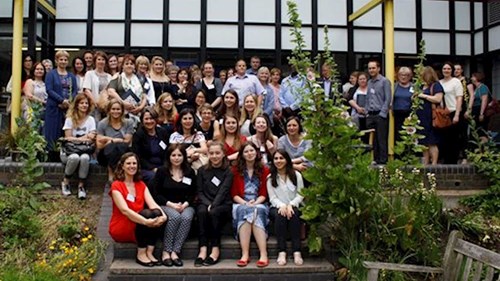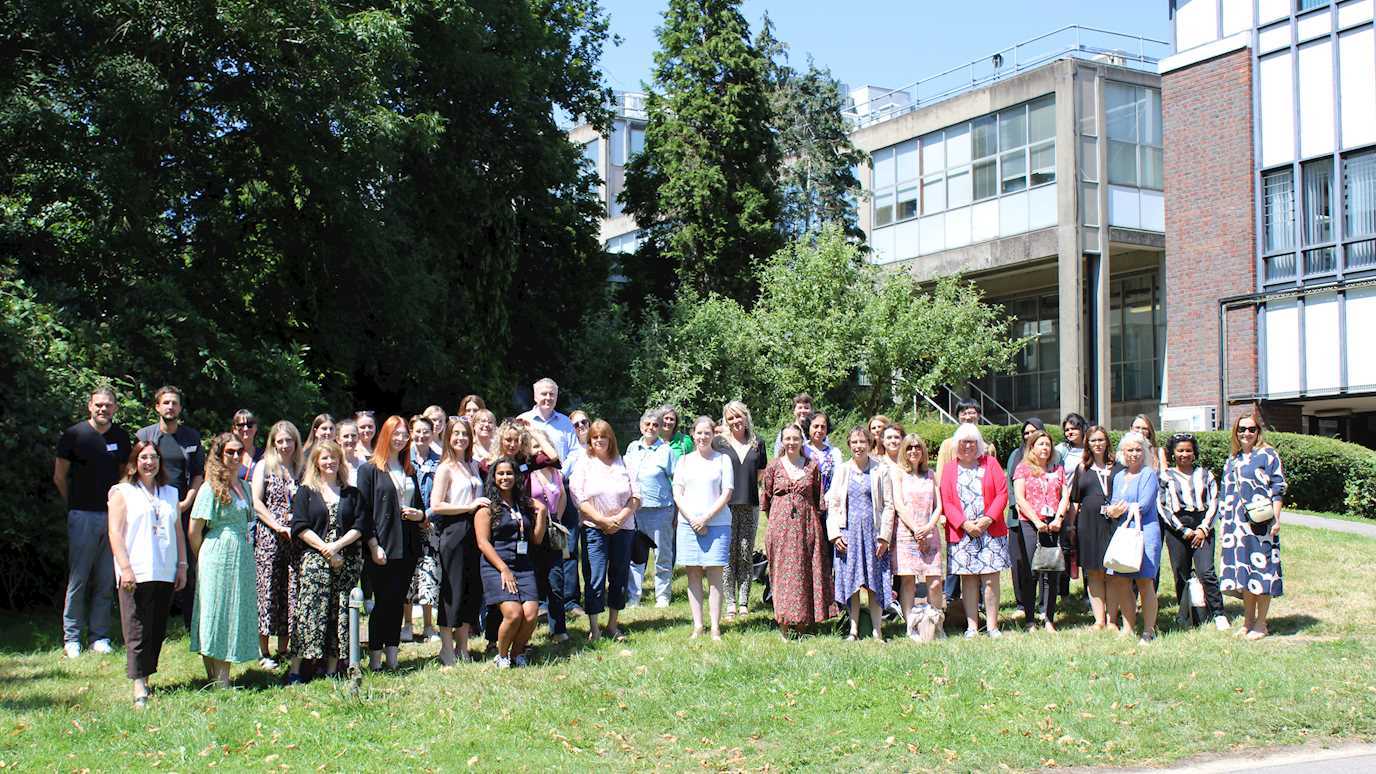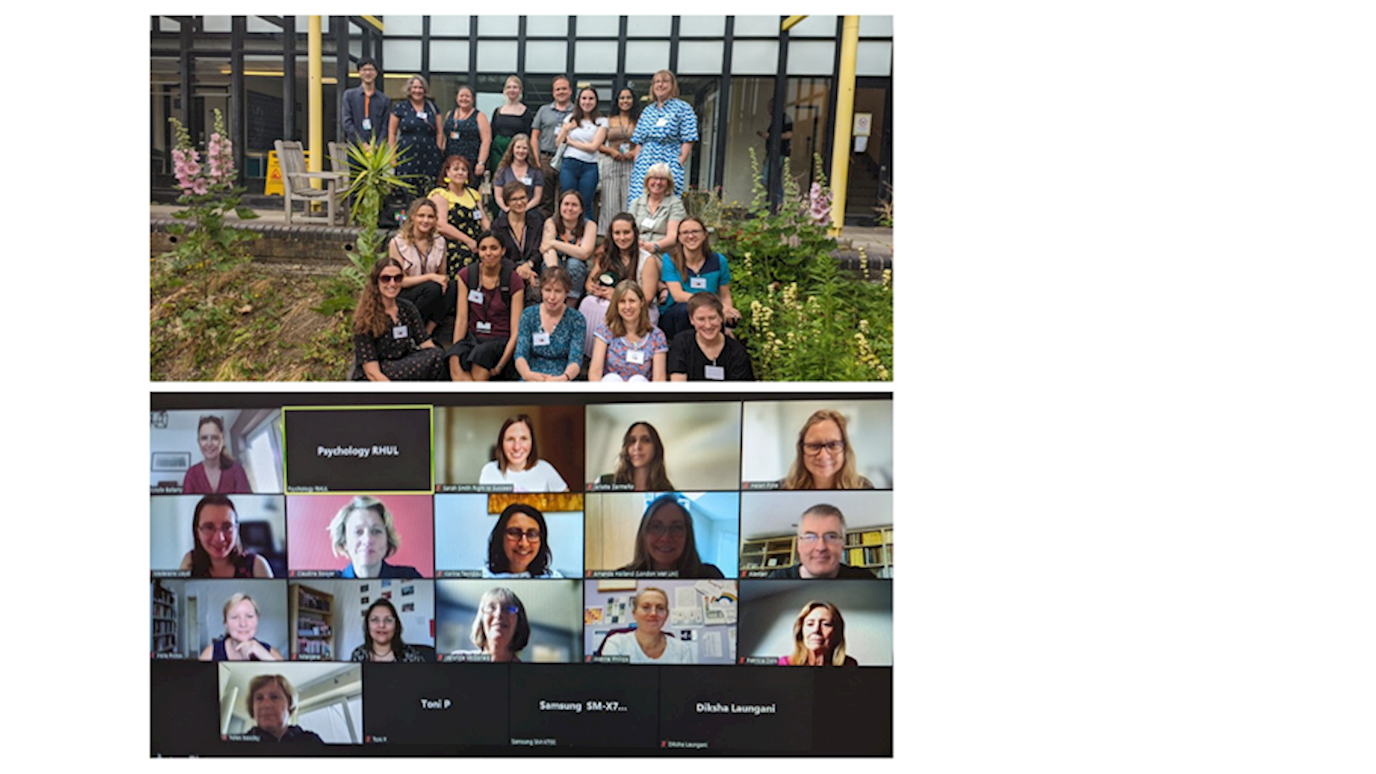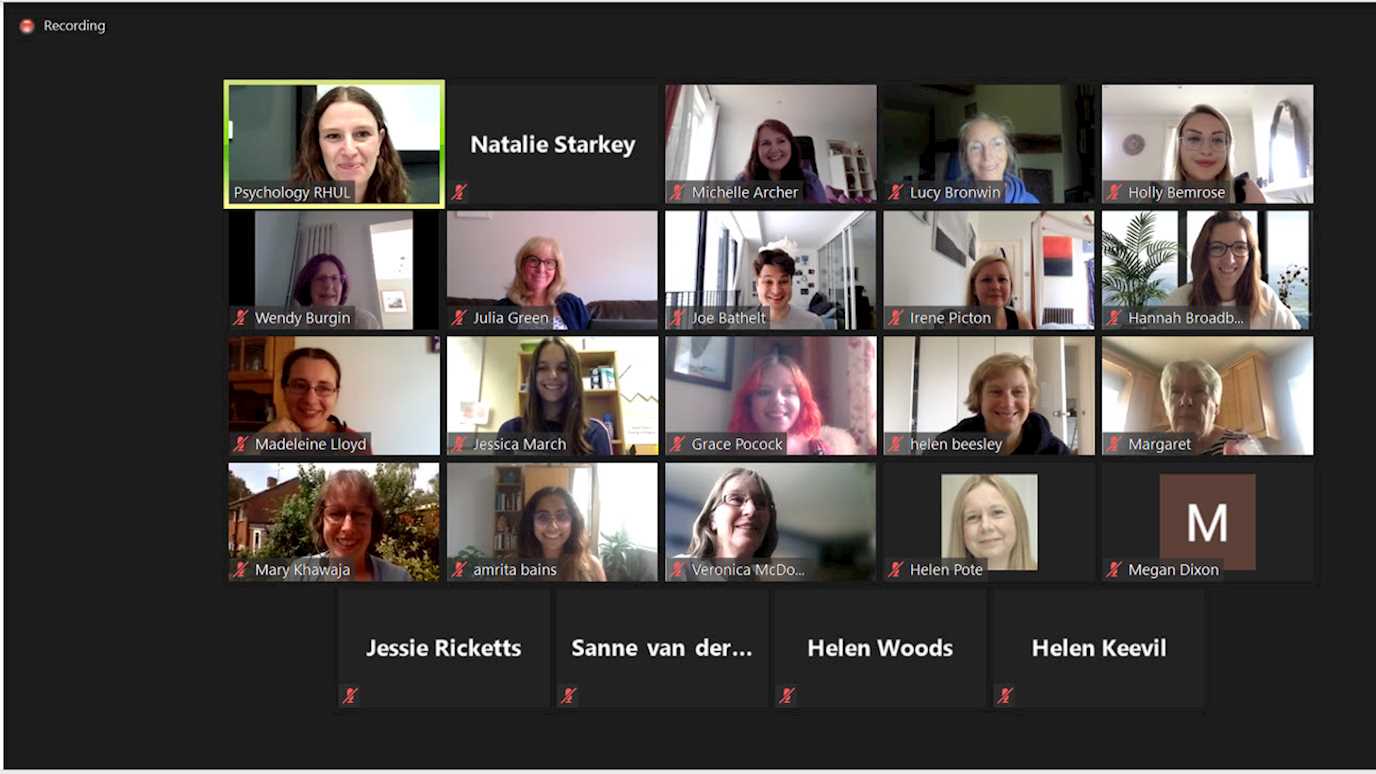On Tuesday 5th July 2016, researchers from the Department of Psychology at Royal Holloway University of London met with a range of teachers, mental health workers, and other professionals working in schools to share research findings and good practice. The day was a great success and we would like to thank everyone who attended for sharing their valuable insights and expertise.
Literacy & Mental Health in Schools
An overview of the day is included below. Videos for all academic talks and electronic copies of posters can be found online here . This event also marked the launch of the South East Research Network for Schools (SERNS), which offers schools the opportunity to participate in research, as well as providing regular updates on new research within psychology and education. You can find out more information and sign up here.
Youtube video of the talks
Academic Talks
In the morning session, research talks were given by academic staff. Professor Kathy Rastle and Dr Jessie Ricketts discussed new research relevant to teaching literacy. Professor Kathy Rastle outlined the relationship between letters, sounds, and meaning in words, and emphasised that any reading intervention should clearly tap into these processes. Kathy highlighted the importance of systematic phonic knowledge for learning to read. She also discussed how morphology provides systematicity in the relationship between letters and meanings, for example, re- has the same meaning in remake, rewire, and reuse. The talk raised some interesting questions, such as whether the teaching of morphology in the new national curriculum is developmentally appropriate, and techniques for motivating secondary students when learning these concepts.
Dr Jessie Ricketts presented research from her Vocabulary and Reading in Secondary Schools (VaRiSS) project, tracking vocabulary and reading across the first three years of secondary school. She has found that 15-20% of pupils are experiencing reading difficulties when they start secondary school. Therefore, it can’t be assumed that all pupils can read at this stage. Jessie also presented results from an experimental study showing that pupils are more likely to learn new oral vocabulary items if they are shown the spellings for these words. This strategy is not only effective but also cheap and easy to employ, since many practitioners already write new words on the board when they are describing their meanings. After the talk there was discussion about methods for exploring the link between oral vocabulary and reading in secondary school, and interventions for those with pre-existing reading difficulties.
Dr Helen Pote, Dr Catherine Sebastian, Dr Alana James, and Dr Dawn Watling presented research on child and adolescent mental health. Dr Helen Pote shared some insights about the reciprocal relationship between poor school attainment and mental health. As £34 billion per year is currently spent on mental health services, Helen indicated that adolescence is a key time for intervention, with many opportunities for effective improvement. Both universal support and targeted mental health approaches are required in schools to assist adolescents. She presented her work on cognitive biases (thinking styles) associated with mental health problems in young people, focussing on the negative cognitive changes that are occurring naturally for adolescents. Follow-up questions queried the types of teenagers who are pre-disposed to mental health difficulties, and the interaction between learning difficulties and mental health.
Dr Catherine Sebastian took a moment at the beginning of her talk to convey how teenagers are great, and highlighted the achievements of some prominent young people over the last ten years. However, she also addressed the fact that adolescence can be tough, due to ongoing brain development and overlapping onset time of a range of disorders. Catherine suggested the need for further neuroimaging research to examine the structure and function of the brain. She also presented data from a large scale project looking at the development of implicit and explicit emotion regulation strategies in adolescents aged 11-16. She answered questions from the audience regarding environmental factors, preventative methods, and mindfulness.
Dr Alana James discussed the use of peer support systems in schools, and their potential impact on social skills, school climate, and bullying. She discussed different approaches schools may use, including befriending, mediation, peer listening, and mentoring. Alana’s talk predominantly focused on the practical aspects required, such as intervention planning and adaptations to suit the individual schools and their processes. After the talk, Alana answered questions about the involvement of parents in peer support schemes, the level of control over training, and the potential conflict of cultural differences.
In the final talk, Dr Dawn Watling explained that shyness and social anxiety are not always exhibited as one would anticipate. She outlined how children are less able to conduct re-appraisal and logically reframe the social situations in which they may feel intimidated. This can lead to prevalence in ‘safety behaviours’, which can lead to poorer quality of friendships and less companionship. She suggested that intervention strategies should focus on tackling social anxiety early on, before it reaches the stage of being a clinical disorder. Dawn’s current research is looking at how social anxiety affects interaction on social media (Facebook and Skype), particularly on how peers may perceive ambiguity (for example, lack of facial recognition) as negative. Questions after the talk enquired about strategies for intervention, and distinguishing between personality traits and symptoms of social disorders.
In addition to the academic talks, there was a lunchtime poster session in which PhD students and research staff were able to present research in progress. The research in the poster session covered a broad range of topics, from emotion regulation and recognition in adolescence, to fMRI research into orthographic learning and morphology. The poster session facilitated a platform for enthusiastic discussion and it was fantastic to see the advice and input given from such a range of educational professionals.
Breakout Discussion Groups
In the afternoon session, practitioners were able to give feedback to researchers on the challenges they face and practical solutions they implement to address them. Key themes included literacy in primary and secondary schools, mental health awareness, resilience in adolescence, and appreciating neurodiversity in children with autism. It was fantastic to see such lively discussion and a lot was covered within the short sessions. We were incredibly pleased that each discussion was well attended by practitioners from a diverse range of educational backgrounds. We will have a similar structure next year and welcome any topic suggestions.
A brief summary of each of the discussions is presented below.
Literacy in Primary School
The break-out discussion focused on the challenges of teaching literacy in primary school. Many practitioners talked about the particular needs of children with English as an additional language (EAL), in that they can often decode written words well using taught phonic skills, but have relatively weaker comprehension of what they have read. This is likely constrained by their oral language skills, which are typically (but not always) more limited than those of children whose native language is English. There was a recognition that at home, EAL children may have limited exposure to English.
There was general consensus that most practitioners are now able to teach decoding using phonics, but that other aspects of literacy are more challenging, for example the teaching of spelling. This may be aided by incorporating explicit teaching of the spelling and meaning of morphological units, such as -er, -ed, re-. Practitioners suggested that it would be very useful to have a catalogue of such morphological units, as there is for phonic rules, as well as strategies for teaching them.
Further issues that were raised included the need to up-skill teaching assistants, as often they work with the most disadvantaged children who may need the most sophisticated interventions. One suggestion was that teaching assistants should be given an individual focus, for example, phonics or morphology, to empower them to become experts in this topic. This will require one-to-one training for teaching assistants. Additionally, there was recognition that summer born (i.e. the youngest) children, as well as boys, often experience weaker oral language skills and that this can constrain many aspects of their learning at school.
Literacy in Secondary School
To open the discussion group, Vicky Sprott from Garth Hill College described their school-wide approach to raising literacy standards. Raising Attainment Through Literacy (RATL) was introduced two years ago in a school of almost 2,000 students with the aim that by the end of Year 8, students would be fluent readers, writers, speakers, and listeners. The initiative is completely cross-curricular, and literacy skills are explicitly taught, and assessed, in all subject areas. This is promoted by RATL displays on the wall in every classroom in the school, each department having a trained member of staff (RATL shakers), and INSET days being used for whole school training.
There was general consensus that secondary schools tend to expect pupils to be ‘secondary ready’ with a completed set of literacy skills, but that this does not match reality. Discussion followed about the high quality of literacy teaching in primary schools, and how best to promote skilled literacy teaching in secondary schools. Explicit grammar teaching came up as being particularly important and there was also some discussion focussing on children who are not able to develop the advanced literacy skills required for GCSEs. Some intervention approaches were discussed, including: teaching groups across all subjects (except maths and science) for low readers; the use of ‘readers’ in mainstream classrooms; and a variety of multi-sensory approaches.
Literacy and Mental Health
Discussions in this group were focused around four questions. Question 1 addressed the links between literacy and mental health. The subject of cause and effect was discussed: can literacy difficulties be a cause of mental health problems (or vice versa), or are there other underlying factors linked to both? It was agreed that repeated ‘failure’ in literacy may lead to poor self-esteem and withdrawal, compounding mental health difficulties and eroding motivation, leading to a downward spiral. Also, parents may have literacy difficulties themselves, which may affect whether they access mental health support for their children.
Question 2 asked whether a dyslexia diagnosis is important for mental health. The general consensus was that it could work either way. For some, it may be a relief to have a label, both in terms of an explanation for the problems experienced, and as a means to access appropriate support. However, for others, it may be stigmatising, and it was suggested that this may particularly be the case for older students.
Question 3 addressed the issue of whether there is a gap in knowledge about the relationship between literacy and mental health. The general agreement was that there is a lack of easily-accessible research in this area. It was suggested that often a lack of time and resources means that one issue is prioritised over the other.
Question 4 asked what the ways forward are in supporting mental health in children and adolescents with literacy difficulties. Suggestions included building resilience, and maximising skills in areas other than literacy, as well as reducing stigma by ‘normalising’ literacy difficulties. Teacher training was also flagged up as being a crucial part of supporting these students over the course of their education.
Resilience in Adolescence
Initially, the discussion focused on the steps schools have taken to develop resilience in pupils using a whole-school approach, such as having school values that instil resilience, creating a culture where students crave feedback that can help them improve instead of just recognising achievements, and modelling failures and risks. For example, students should be encouraged to take risks outside of their comfort zones and not be afraid of failure (e.g. Duke of Edinburgh is a great way of building resilience). One school also mentioned that they have Emotional Literacy Support Assistants (ELSAs) in addition to school councillors, and they work alongside educational psychologists. Finally, it was mentioned that it is important to build the resilience of teachers and recognise the difficulties teachers face.
Next, practitioners discussed targeted approaches specific to pupils with challenging behaviours, or who were otherwise vulnerable. Some suggested consulting professionals and buying in specialist support, or buying bespoke training packages (e.g. dealing with self-harm). Students should be educated in basic emotional awareness and understanding about resilience. Exercise and mindfulness programmes can be useful and some found that exercise programmes in the morning helped students focus better. Additionally, the challenges involved in the transition from primary to secondary school may at present be somewhat under-appreciated.
There was also discussion about gaps in knowledge that practitioners would like developmental psychologists to address. Currently there are different measures and scales for measuring resilience, but many of these scales combine several aspects of personality rather than resilience alone. Additionally more needs to be known about young people's perception of their own resilience. Resilience implies that life is always hard, is there another term that can be used instead? People also wanted to know whether resilience is a fixed and stable trait or whether it can be taught, and if so, how?
Running and Evaluating Peer Support Systems
It was evident from the discussion group that peer support systems are used in many educational institutions, with varying methods of practice and different levels of success. Practitioners first discussed their experience of using peer support systems and issues that they had encountered. Then, attendees considered what the aims of their current/planned peer support systems were, and how to monitor and evaluate the system to meet these needs.
The majority of the group had some form of peer support system in their school, or experience of systems in other organisations. The focus for most systems was on academic intervention, with fewer instances of systems specifically aimed to support pupils’ mental well-being. It was positive to hear from practitioners whose schools had an established peer support system in place, though they noted that it was a big undertaking to implement and maintain a successful system.
There was a general consensus that many factors influence the extent to which a pupil supporter can successfully support their peers, including their age, maturity level, and motivation. It was suggested that compulsory training could be beneficial for peer supporters, so that they gain skills for supporting others and benefit in terms of their own personal development.
Most attendees agreed that establishing an effective system would be dependent on a whole-school initiative, requiring a heavy time investment and a clear division of labour between school staff. Several group members commented on the benefits of having a partner school, in order to be held accountable and share best practice. It was also suggested that pupil questionnaires were used to develop a targeted approach and address the issues most beneficial to the school population. Overall, the success of peer support systems appeared to be dependent on knowing the desired outcomes, working towards these, and maintaining consistency.
Appreciating neurodiversity: Supporting children and young people on the autism spectrum
Most practitioners who attended this discussion had experience of working with children and young people with an Autism Spectrum Condition. The session started by collectively defining “neurodiversity” as the differing ways in which people think and see the world, with this being particularly enhanced for autistic people.
We then discussed the strengths of autistic children and young people in educational settings, such as honesty and trueness to self, methodical approaches, good memory, attention to detail, and enthusiasm for interests. Some of the potential challenges identified included feelings of isolation due to diagnosis, and anxiety with daily tasks and social interaction. Some practitioners noted that social anxiety was particularly prevalent in girls with autism, which they often masked or camouflaged to fit in with peers.
The group moved on to discuss strategies to make the most of an autistic individual’s strengths and combat challenges. Several practitioners supported the use of social stories to reduce social anxiety. “One page profiles” had also been used to help familiarise staff with individual children. However, some schools expressed that it was an unnecessary demand on time and resources. This was contested within the group, as clear communication about an individual’s strengths and difficulties could aid the learning experience. Further, the use of “traffic light” cards, which individuals could use to express their feelings, had also been very popular in ensuring engagement and reducing anxiety at school.
The discussion concluded with the idea that an approach that appreciated neurodiversity and focused on the individual could improve teaching for those on the autism spectrum, and make the most of their strengths. It was also suggested that if all staff could incorporate various strategies into teaching, it would lead to wider acceptance, knowledge, and understanding. With the recent announcement that autism training will be mandatory within teacher training, we are hopeful that schools can become accepting and supportive places for all who think a bit differently.
Supporting mental health awareness in schools
To open the discussion group, school staff shared their key challenges to supporting mental health awareness in schools. The group agreed that challenges included having limited resources and that they must support young people while they are waiting to be seen by a CAMHS service. Other key challenges involved identifying young people in need, confusion regarding how to refer to a CAMHS service, and, importantly, when to refer. Finally, the group discussed dealing with the stigma of mental health in schools and encouraging young people to talk about their emotional wellbeing.
In terms of overcoming some of these challenges, the group shared current practices that have proven successful, such as staff attending Risk and Resilience training and utilizing an Emotional Literacy Support Systemfor young people. School staff reported that the Emotional Literacy Support System encourages a supportive environment for young people, improving students’ self-esteem, and facilitates the parent-school relationship. The support and training offered by the Targeted Mental Health in Schools (TAMHS) project was discussed and schools that were involved with the project shared their experiences of the mental health awareness training provided by TAMHS. Staff whose schools were not involved were encouraged to sign up to Surrey TAMHS. In terms of identifying young people in need, the use of the Strength and Difficulties Questionnaire was suggested as a way of understanding and quantifying a young person’s emotional and/or behavioural difficulties. Dr Helen Pote also discussed the MindAid app that she is currently developing, which aims to assist school staff in identifying mental health difficulties in young people, dealing with a crisis, and how to make a referral to a local CAMHS service.
Future Practitioner Events
Dr Jessie Ricketts who organised the day said “we hope that the event will foster ongoing collaboration between us as researchers and our colleagues who work with children and adolescents in a school setting”. We would like to warmly invite you to join us again next year, which we will contact you about in due course. For those who were unable to attend the practitioner event this year, you are welcome to contact Dr Jessie Ricketts on jessie.ricketts@rhul.ac.uk, in order to be added to our mailing list and invited to future events. We look forward to seeing you again next year!

























